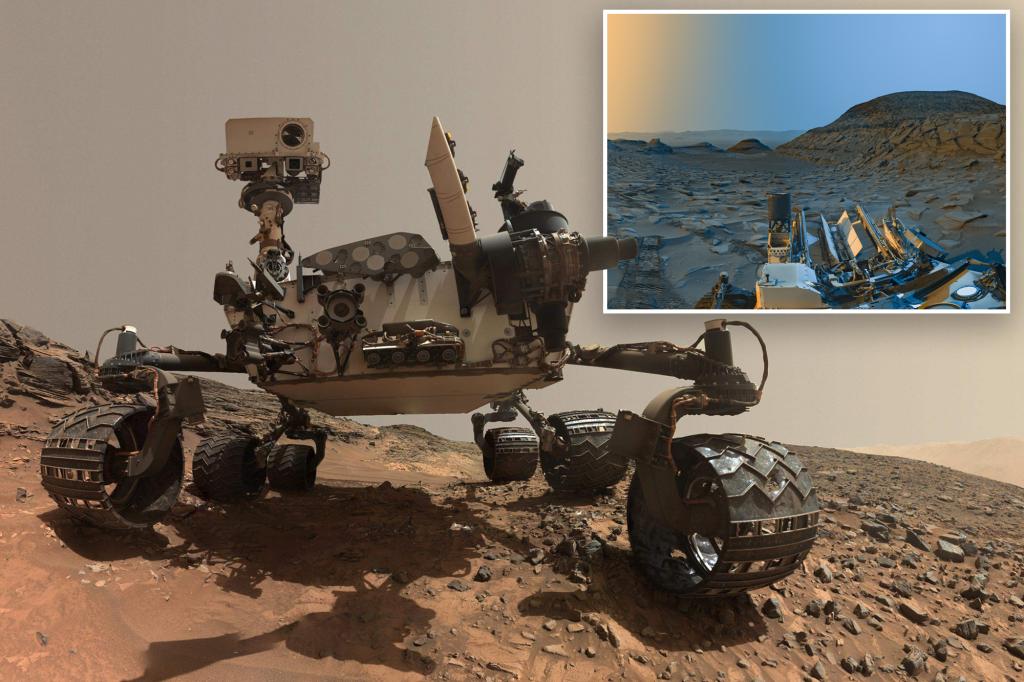A groundbreaking instrument on NASA’s Mars Perseverance rover is considered a mission success after producing enough oxygen for a small dog to breathe for about 10 hours.
The Mars Oxygen In Situ Resource Utilization Experiment, or MOXIE, is a microwave-sized device that takes in unbreathable Martian air and converts it into oxygen that humans and dogs depend on.
The team behind the experimental instrument recently revealed that since Percy landed on Mars, MOXIE has been running like a dream.
MOXIE has generated 122 grams of oxygen since 2021, producing about 12 grams of oxygen per hour.
Because NASA knows we love a good animal analogy, the space agency said this is enough for a small dog to breathe for about 10 hours.
That may not seem like much, but it’s more than double NASA’s initial goal for MOXIE.
Oxygen is also 98% pure or better.
NASA’s Curiosity Mars rover used its black and white navigation cameras to capture panoramas at two times of day on April 8, 2023.NASA/JPL-Caltech
 This NASA file photo released on June 7, 2018 shows a low-angle self-portrait of NASA’s Curiosity Mars rover at the site from which it ducked to drill a rock target called “Buckskin” in the comes down from Mount Sharp. AFP/Getty Images
This NASA file photo released on June 7, 2018 shows a low-angle self-portrait of NASA’s Curiosity Mars rover at the site from which it ducked to drill a rock target called “Buckskin” in the comes down from Mount Sharp. AFP/Getty Images
“MOXIE’s impressive performance demonstrates that it is feasible to extract oxygen from the Martian atmosphere, oxygen that could help supply breathing air or rocket propellant to future astronauts,” said NASA Deputy Administrator Pam Melroy. “Developing technologies that allow us to utilize resources on the Moon and Mars is critical to building a long-term lunar presence, creating a robust lunar economy, and allowing us to support an initial human exploration campaign on Mars.”
MOXIE works through an electrochemical process, separating carbon dioxide molecules into oxygen and carbon monoxide molecules.
As these gases flow through the system, they are analyzed for the purity and quantity of oxygen produced, according to NASA.
 In this March 4, 2021 image, wheel marks are left on the floor of Jezero Crater on Mars, as NASA’s Perseverance rover makes its way across the Martian surface for the first time. Via REUTERS
In this March 4, 2021 image, wheel marks are left on the floor of Jezero Crater on Mars, as NASA’s Perseverance rover makes its way across the Martian surface for the first time. Via REUTERS
 The Perseverance rover is seen in a “selfie” taking over a rock nicknamed “Rochette” on September 10, 2021 via REUTERS
The Perseverance rover is seen in a “selfie” taking over a rock nicknamed “Rochette” on September 10, 2021 via REUTERS
The achievement is exciting because when humans travel to Mars, they will be able to produce oxygen and fuel on the Red Planet instead of carrying all of its resources with them.
Using materials from the earth to survive is a technique called in situ resource utilization or ISRU.
MOXIE principal investigator Michael Hecht of MIT said the instrument has inspired the ISRU community.
 This NASA illustration shows a simulated view of NASA’s interior exploration using seismic investigations, geodesy and heat transport, firing retrorockets to slow them down as they descend toward the surface of Mars. AFP/Getty Images
This NASA illustration shows a simulated view of NASA’s interior exploration using seismic investigations, geodesy and heat transport, firing retrorockets to slow them down as they descend toward the surface of Mars. AFP/Getty Images
 NASA’s Perseverance rover is seen on Mars in an undated illustration provided by the Jet Propulsion Laboratory in Pasadena, California via REUTERS
NASA’s Perseverance rover is seen on Mars in an undated illustration provided by the Jet Propulsion Laboratory in Pasadena, California via REUTERS
“It showed that NASA is willing to invest in these types of future technologies. And it has been a flagship that has influenced the exciting space resources industry,” said Hecht.
The concept can be used to create a large-scale system with an oxygen generator like MOXIE and a way to store the oxygen produced.
NASA shared audio of MOXIE’s air compressor running on the Red Planet.
 NASA’s Curiosity Mars rover used its black-and-white navigation cameras to capture panoramas at two times of day on April 8, 2023.Reuters
NASA’s Curiosity Mars rover used its black-and-white navigation cameras to capture panoramas at two times of day on April 8, 2023.Reuters
Listen to the instrument pumping on Mars below.
On August 7, MOXIE generated oxygen for the sixteenth and final time aboard the rover before concluding operations.
Categories: Trending
Source: vtt.edu.vn
